
Note for customers: As of 2025, Trece, Inc. has discontinued all secondary packaging, such as the one shown in some of the images below. GPA imports Trece, Inc. products in bulk and supplies them without secondary packaging. Images shown on this page are for representation only.
The Trece Storgard Insect Monitoring system
- Trece Inc.(Trece)’s Storgard Insect Monitoring Systems (Storgard) is the world’s leading pheromone product range for detecting and estimating stored product pests (SPPs).
- Giridhar Pai Associates (GPA) is Asia’s sole authorized distributor of Trece products.
- GPA supplies Storgard pheromone traps and lures to monitor all common Asian stored product beetle and moth pests.
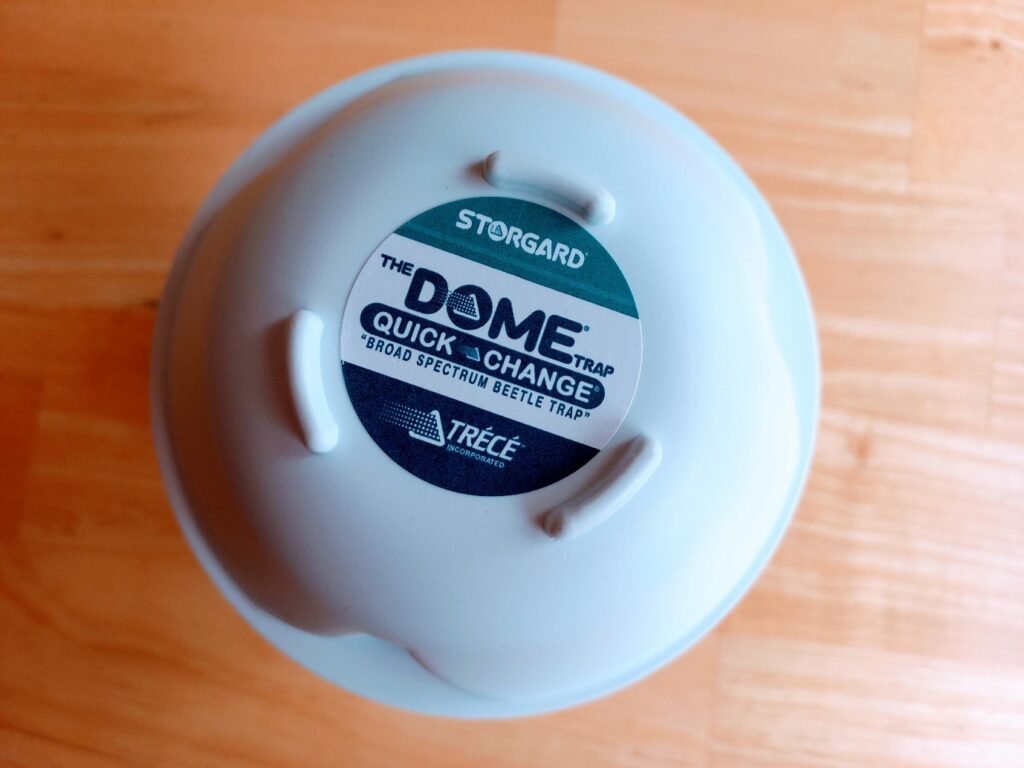
Storgard Quick Change Dome Trap
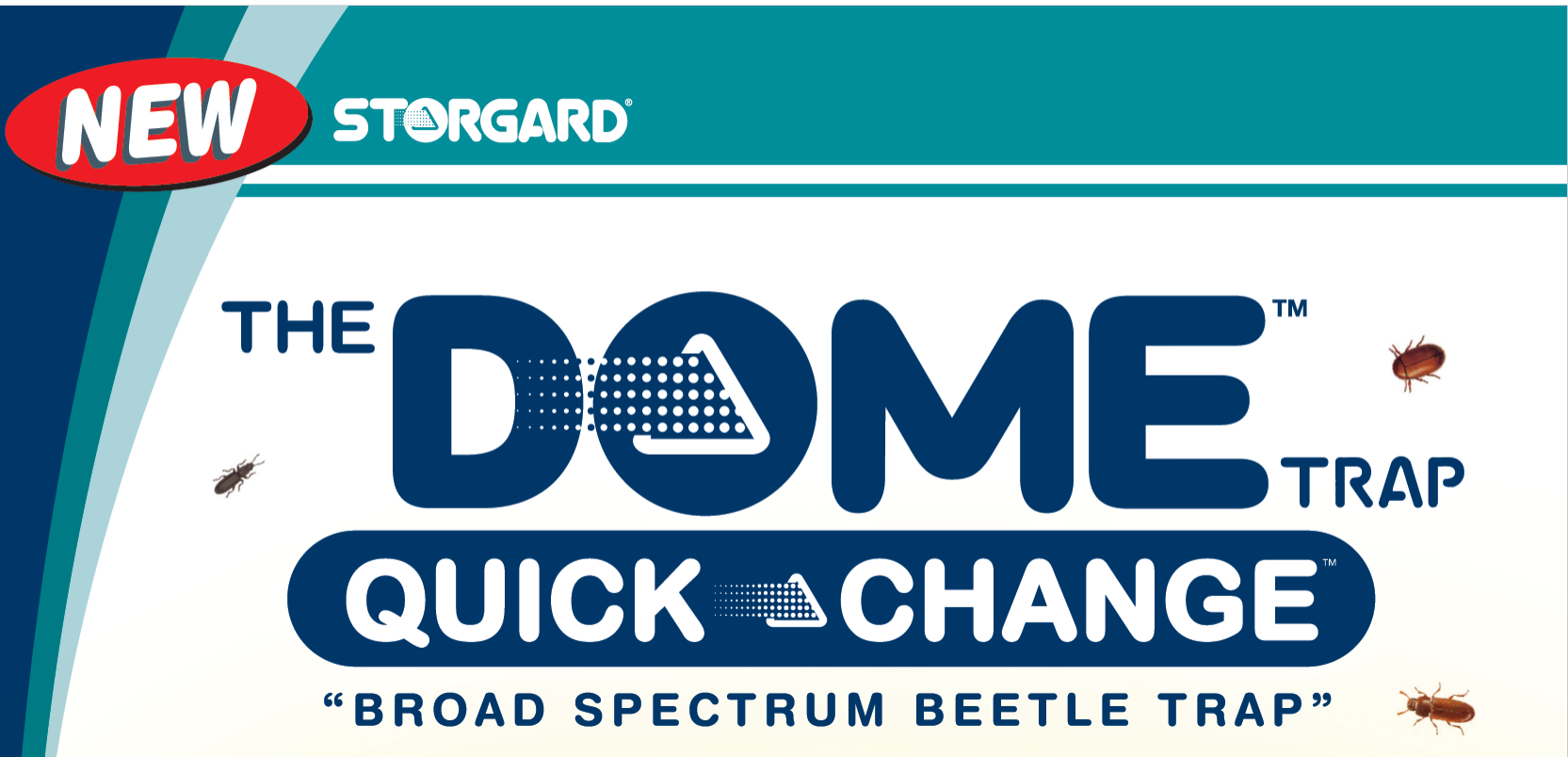
Storgard Quick Change Dome Trap
The Storgard Quick Change (QC) Dome Trap
- The QC Dome is an improved version of the Dome Trap, with both traps functioning similarly.
Storgard pheromone traps and lures to monitor stored product beetles
- The latest Storgard range to monitor stored product beetle pests is the Quick Change (QC) Dome, Trece’s highly improved version of the Storgard Dome Trap, popular worldwide since the nineties of the twentieth century.
- In the QC Dome, Trece has combined the pheromone lure and the kairomone into a lure tray and created a superior version of its highly popular Dome Trap system. The QC Dome has a new Quick Change Snugfit lure that has improved pest attraction and trapping power.
- The QC Dome’s improved pheromone lure formulation, and the two kairomones make its lure tray more effective in monitoring male and female stored product beetles than the previous lure plus kairomone oil combination in the Dome Traps. Regular pheromone lures of other brands can only monitor male beetles and thus underestimate the target beetle pest population.
- GPA introduced the QC Dome to Asian customers in late 2024. By early 2025, numerous customers had switched to the new and improved version of the Storgard Dome Trap to monitor stored product beetle pests like cigarette beetles (CB), confused and red flour beetles (CFB/RFB) and khapra and warehouse beetles (KB/WB).
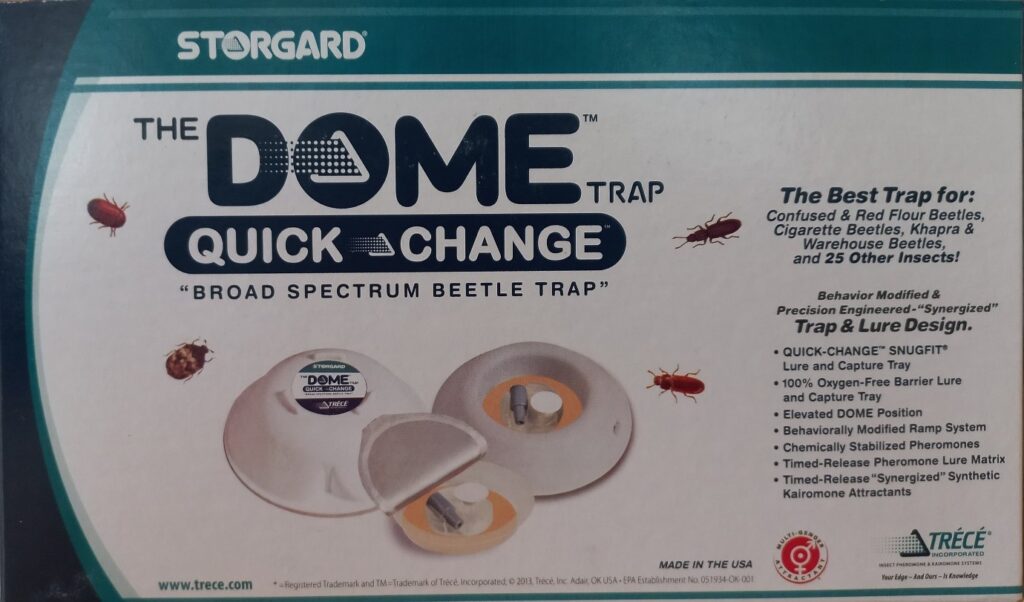
Trece Storgard Quick Change Dome Trap Kit
Components of QC Dome Trap Master PCO Kit
- The Quick Dome Trap Master PCO Kit is a two-component system of Quick Change Dome traps and lures trays that contain pheromones and two kairomones. QC Dome Trap Master PCO Kits are available for CB, CFB/RFB and KB/WB.
- The Trece Storgard QC Dome Trap pheromone range includes an Ultra-combi lure tray that contains the pheromones of CB, CFB/RFB and KB/WB.
- In addition, the Ultra-combi lure tray contains two kairomones that attract seven other common Asian stored product beetle pests: the Drugstore Beetle, the Rusty Grain Beetle, the Granary Weevil, the Maize Weevil, the Rice Weevil, the Red Legged Ham Beetle, and the Saw-Toothed Grain Beetle.
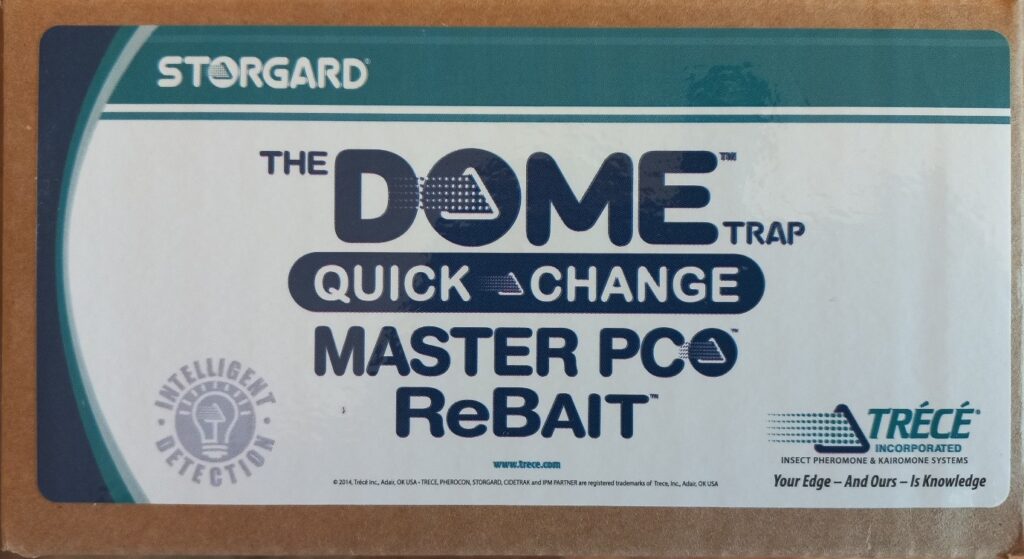
Storgard Quick Change Dome Trap Master PCO ReBait kit of lure trays
Storgard Quick Change Dome Trap Benefits
DURABLE
- The Storgard Quick Change Dome Trap is made of plastic and is suitable for long-term field use through lure tray replacement only once every two months.
SPACE SAVING
- The Quick Change Dome Trap’s compact design allows for its use in tight spaces like inside pallets or below stored-product racks.
EASY TO USE
- Quick Change Dome Traps are easier to deploy quickly and are amenable to fast replacement of lure trays and periodic counting of trapped insects compared to the older Dome Traps.
EFFECTIVE
- The Quick Change Dome Trap consistently captures male and female target stored product beetle pests to highlight and pinpoint their presence even at very low population levels.
LOW-COST
- The Dome Trap requires only one in two-month lure tray replacements to attract and trap insects, reducing pheromone monitoring costs.

Pack of 25 Trece Storgard IMM+4 Pheromone Lure Pouches
Storgard Quick Change Dome Trap Use Instructions
- 1. Trap placement: Place the trap in a grid pattern, leaving a space of 15-20 metres between CB and KB/WB traps and 10 metres between CFB/RFB traps.
- 2. Identification: Mark the lure type and trap number on the trap for easy identification and maintain a trap location map.
- 3. Placement :Place the QC Dome Trap on the floor, ledges, baled products, or pallets where you can easily access it weekly to count the trapped beetles.
- 4. Lure tray replacement: Replace QC lure trays periodically once every two months.
- 5. Periodic inspection:Check the QC Dome traps once weekly and remove the trapped insects and debris. Remember that the traps may also attract non-target beetle pests.
- 6. Ensure the trap’s ability to trap: Check the QC Dome traps once weekly and remove the trapped insects and debris. Remember that the traps may also attract non-target beetle pests.
- 7. Maintenance: Clean the QC Dome trap top and bottom with soapy water every three months.
- 8. Counting and corrective action: Maintain a record of the QC Dome trap catches of the target pest and plan appropriate action in response to the beetle counts.

Trece Storgard Quick Change Dome Trap with the first version of the lure tray
How is the new QC Dome Trap different from the old Dome Trap?
Quick Change Lure Tray
- A Quick Change (QC) lure tray containing the pheromone lure, and two kairomones replace the separate pheromone lures and kairomone food attractant oil of the old Dome Trap.
Two kairomones
- The QC lure trays have two kairomones, including the food attractant oil of the old Dome, for greater broad-based pest attraction.
Controlled pheromone and kairomone release
- The QC lure tray is tuned to control the release of pheromone and kairomone for effective and regular pest trapping.
Multi-species attraction
- The Ultra-combi QC lure tray attracts and traps over thirty stored beetle pests, including less-known species (note that some of the species attracted by the Ultra-combi QC lure tray may not occur in the Asian continent).
Cost and time saving
- The QC lure tray costs less and requires less time to set up, maintain and replace than the pheromone lure and kairomone oil of the old Dome Trap.
Storgard pheromone traps and lures to monitor stored product moth pests
- Storgard traps for monitoring stored product moths include the diamond-shaped Storgard II trap. The Storgard II trap combined with the IMM+4 pheromone lure can monitor common stored product pests like the almond moth.

Trece Storgard II Moth Trap Kit showing the diamond-shaped Storgard II Trap and IMM+4 Pheromone Lure Pouch
Storgard II Moth Trap Use Instructions
- 1. Trap placement: Place the trap in a grid pattern, leaving a space of 15-20 metres between traps.
- 2. Identification: Mark the trap number on the trap for easy identification and maintain a trap location map.
- 3. Placement :Hang the Storgard II trap on the racks or walls using the twist-ties with the trap where you can easily access it weekly to count the trapped moths.
- 4. Lure tray replacement: Place the IMM+4 lure on the Storgard II trap’s glued surface and replace the trap and the lure once every two months.
- 5. Periodic inspection:Check the Storgard II traps once weekly and plan the action based on the trap counts.
- 6. Counting and corrective action: Maintain a record of the Storgard II trap moth catches and plan appropriate action in response to the counts.
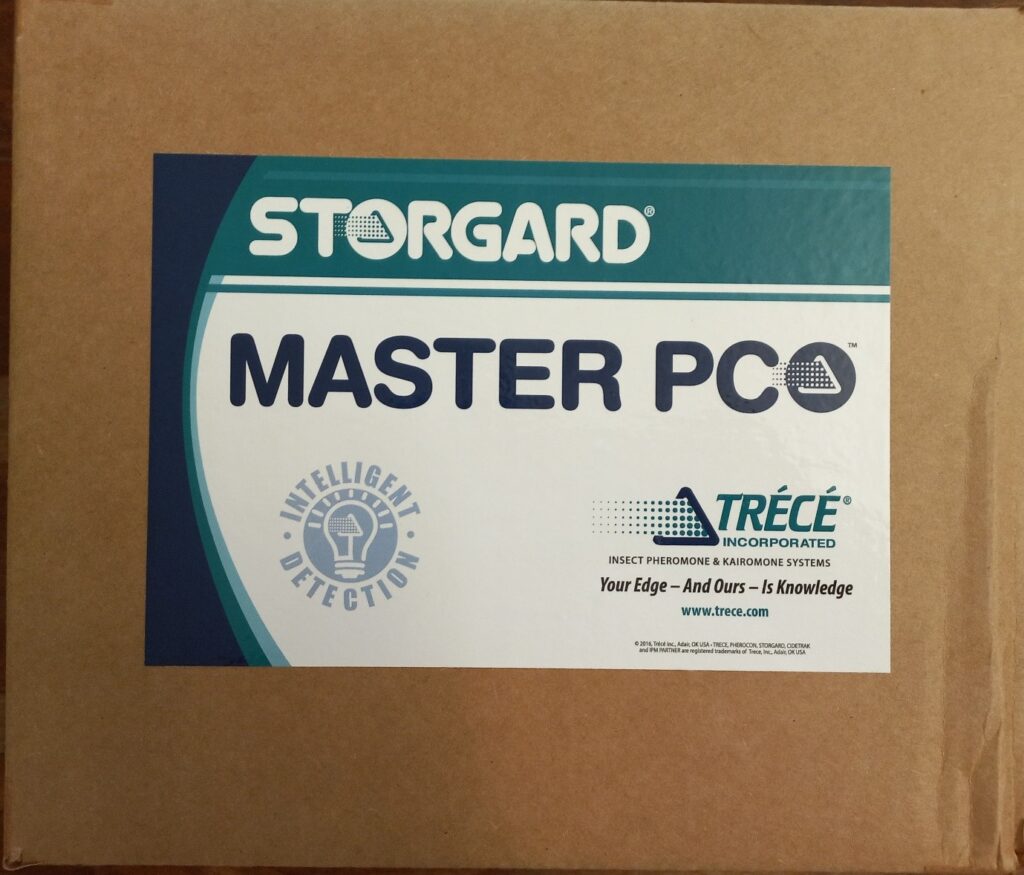
Trece Storgard Master PCO Dome Trap Kit Box
Stored product pest moths and beetles that can be monitored with Storgard pheromone traps and lures
| Stored product moths | |
|---|---|
| Common name | Scientific name |
| Almond Moth | Cadra cautella |
| Raisin Moth | Cadra figulilella |
| Tobacco Moth | Ephestia elutella |
| Indian Meal Month | Plodia interpunctella |
| Mediterranean Flour Moth | Ephestia kuehniella |
| Webbing Clothes Moth | Tineola bisselliella |
| Angoumois Grain Moth (AGM) | Sitotroga cerealella |
| European Grain Moth | Nemapogon granella |
| Casemaking Clothes Moth | Tinea pellionella |
| Stored product beetles | |
|---|---|
| Common name | Scientific name |
| Cigarette Beetle | Lasioderma serricorne |
| Confused Flour Beetle | Tribolium confusum |
| Red Flour Beetle | Tribolium castaneum |
| Warehouse Beetle | Trogoderma variabile |
| Khapra Beetle | Trogoderma granarium |
| Lesser Grain Borer | Rhyzopertha dominica |
| Larger Grain Borer | Prostephanus truncatus |
| Sawtoothed Grain Beetle | Oryzaephilus surinamensis |
| Merchant Grain Beetle | Oryzaephilus mercator |
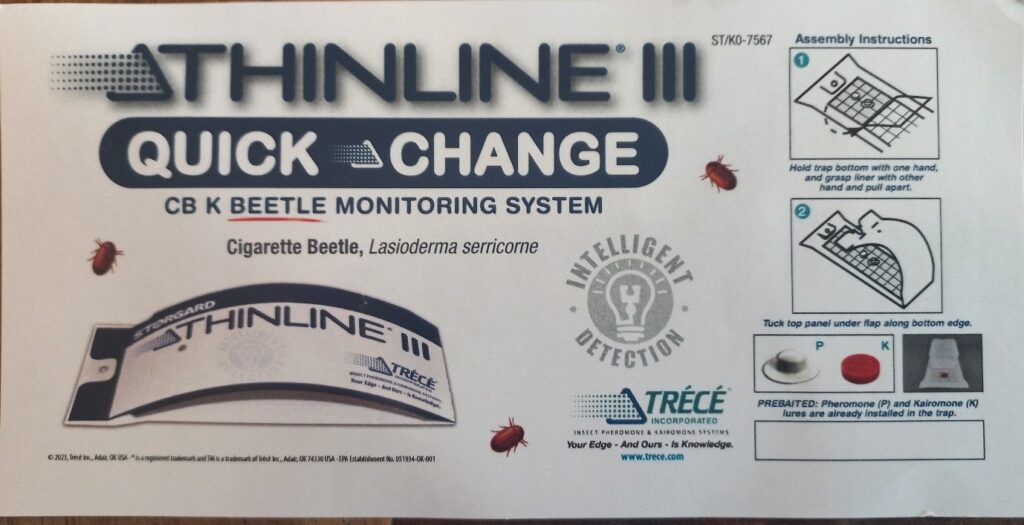
Trece Storgard Thinline III CB+K Trap
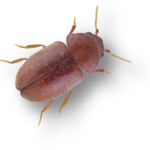
Stored product beetle and moth pest-wise pheromone traps and
lure kits avaialble in India
| Insect | Details | Kit Content |
|---|---|---|
| Cigarette Beetle (CB) OR Confused or Red Flour Beetle (CFB/RFB) OR Khapra and Warehouse Beetle (KB/WB) | Quick Change Dome Master PCO Kit Rebait Lure Trays Kit | 25 QC Dome traps, 25 Lures Trays 25 Lure Trays |
| Indian Meal Moth plus Mediterranean Flour Moth, Raisin Moth, Tobacco Month, and Almond Moth (IMM+4) | Storgard II Master PCO Kit Pheromone Lures Kit | 25 Storgard II Traps, 25 IMM+4 Pheromone Lures 25 IMM+4 |
| Cigarette Beetle (CB), Confused or Red Flour Beetle (CFB/RFB), Khapra and Warehouse Beetle (KB/WB) plus seven other beetles (Drugstore Beetle, Rusty Grain Beetle, Granary Weevil, Maize Weevil, Rice Weevil, Red Legged Ham Beetle, and Saw-Toothed Grain Beetle) | Ultra Combi Quick Change Dome Master PCO Kit Ultra Combi Rebait Lure Trays Kit | 25 QC Dome traps, 25 Lures Trays 25 Lure Trays |
| Cigarette Beetle (CB +K) | Thinline III Master PCO Kit | 25 Thinline III Traps, 25 CB+K Lures |
Frequently Asked Questions (FAQs) on the Trece Storgard Insect Monitoring System:
There are many types of stored product pest pheromones, of which sex and aggregation pheromones are common. The Storgard Cigarette Beetle (CB) pheromone lures that attract male beetles and the Indian Meal Moth (IMM+4) pheromone lures that attract male moths are examples of sex pheromones. The Storgard Confused Flour Beetle / Red Flour Beetle (CFB/RFB) pheromone lure is an example of an aggregation that attracts female and male insects.
Yes, Trece has the Ultra-combi Quick Change Lure tray, which contains the pheromones of cigarette beetles (CB), confused and red flour beetles (CFB/RFB) and khapra and warehouse beetles (KB/WB). The Ultra combi lure tray can attract all five of those insect types.
A kairomone is an attractant of insects secreted by one organism to attract another organism. Storgard Quick Change (QC) Dome trap lure-trays contain two food attractant kairomones, one solid and another liquid, enhancing the QC Dome trap’s performance in attracting beetles
We suggest you check the Storgard Change Dome traps at least once weekly. You can check the traps more frequently if the insect activity increases.
While in use, remove the debris and dead insects from the lure tray of the trap during each count to make it easier for the next count. Once quarterly, clean the trap Dome (cover) and reservoir with soap to remove dirt.
Occasional capture: Indicates a future insect problem and the need for more intensive observations. As trap counts increase, tighten the trap grid and remove infested products.
High capture: Indicates the need for action to identify and remove infested products, followed by improved hygiene in small areas. Applying pesticide sprays on surfaces surrounding the infested product may also be needed.
Consistent high capture: Indicates a need for increased cleaning practices and a widespread treatment against insects, such as heat treatment or fumigation.
We suggest refrigerated or frozen storage of Storgard pheromone lures to ensure longevity and effectiveness.
No. You can only monitor stored product insect pests by using pheromone traps. You will need to use chemical pesticides to control stored product insect pests.
There are two types of pheromone trap count thresholds: average insect per trap and the maximum insect per trap, both during the count period. Exceeding the count threshold should result in an inspection to detect the source of infestation.
We recommend that you check the Storgard pheromone traps at least once weekly. Increase the checking frequency if you find higher insect activity.
The weekly pheromone trap counting should consider inspection to detect infestation if the established threshold is breached. After the infestation source is detected, better cleaning, removal of infested product, chemical pesticide spray application and treatment of infested products are required.
Pheromone traps can be used in storage, manufacturing, and even transit. They are useful for detecting and identifying the source of stored product insect infestation in the supply chain.
No, zero pheromone trap counts do not indicate any infestation as pheromones attract only males in the case of sex pheromones, and the traps do not attract other active insect life stages – larvae. Zero trap counts indicate possibly low or no infestation but must be corroborated by physical inventory inspection of old products to check for insect presence.
You are most likely having larvae of Ephestia cautella or the almond moth in your product. We suggest you use IMM+4 pheromone lures with a moth trap to monitor your premises’ adult almond moth population.
Storgard pheromone lures stored even in ambient conditions can last up to a year. We suggest that you refrigerate the pheromone lures, which can last up to two years. Placing them in a freezer will ensure the pheromone lure’s effectiveness for more than two years of storage.

 13.Do zero pheromone trap counts indicate no infestation?
13.Do zero pheromone trap counts indicate no infestation?